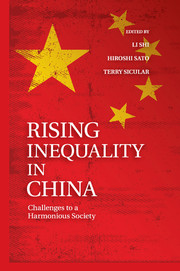Book contents
- Frontmatter
- Contents
- List of Tables
- List of Figures
- Contributors
- Preface
- Abbreviations
- Glossary
- 1 Rising Inequality in China
- 2 Overview
- 3 Housing Ownership, Incomes, and Inequality in China, 2002–2007
- 4 Educational Inequality in China
- 5 Inequality and Poverty in Rural China
- 6 The Evolution of the Migrant Labor Market in China, 2002–2007
- 7 A New Episode of Increased Urban Income Inequality in China
- 8 Unemployment and the Rising Number of Nonworkers in Urban China
- 9 Do Employees in the Public Sector Still Enjoy Earnings Advantages?
- 10 Redistributive Impacts of the Personal Income Tax in Urban China
- 11 Changes in the Gender-Wage Gap in Urban China, 1995–2007
- 12 Intertemporal Changes in Ethnic Urban Earnings Disparities in China
- Appendix I The 2007 Household Surveys
- Appendix II The 2002 and 2007 CHIP Surveys
- Index
- References
4 - Educational Inequality in China
The Intergenerational Dimension
Published online by Cambridge University Press: 05 July 2013
- Frontmatter
- Contents
- List of Tables
- List of Figures
- Contributors
- Preface
- Abbreviations
- Glossary
- 1 Rising Inequality in China
- 2 Overview
- 3 Housing Ownership, Incomes, and Inequality in China, 2002–2007
- 4 Educational Inequality in China
- 5 Inequality and Poverty in Rural China
- 6 The Evolution of the Migrant Labor Market in China, 2002–2007
- 7 A New Episode of Increased Urban Income Inequality in China
- 8 Unemployment and the Rising Number of Nonworkers in Urban China
- 9 Do Employees in the Public Sector Still Enjoy Earnings Advantages?
- 10 Redistributive Impacts of the Personal Income Tax in Urban China
- 11 Changes in the Gender-Wage Gap in Urban China, 1995–2007
- 12 Intertemporal Changes in Ethnic Urban Earnings Disparities in China
- Appendix I The 2007 Household Surveys
- Appendix II The 2002 and 2007 CHIP Surveys
- Index
- References
Summary
Introduction
The intergenerational distribution of education has received less attention from economists than has the intragenerational distribution. Yet, the degree of intergenerational transmission of education – the transfer of educational outcomes from parents to children – is an important determinant of the distribution of education among households at any point in time. This, in turn, influences the distribution of income among households.
There are two concepts of intergenerational mobility. One focuses on aggregate mobility, that is, the extent to which the average education of one generation exceeds that of the previous generation. In the aggregate, economic growth, household incentives, and the policies of the state can all serve to promote mobility. A second concept focuses on mobility at the microeconomic level, that is, the extent to which the education of an individual depends on, or is related to, the education of her parents. In this case, state policies that equalize educational opportunities may be offset by the tendency for children of better-educated parents to receive more education than children of less well-educated parents.
- Type
- Chapter
- Information
- Rising Inequality in ChinaChallenges to a Harmonious Society, pp. 142 - 196Publisher: Cambridge University PressPrint publication year: 2013
References
- 10
- Cited by



